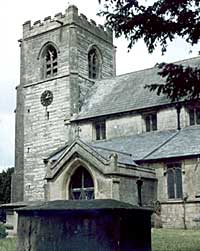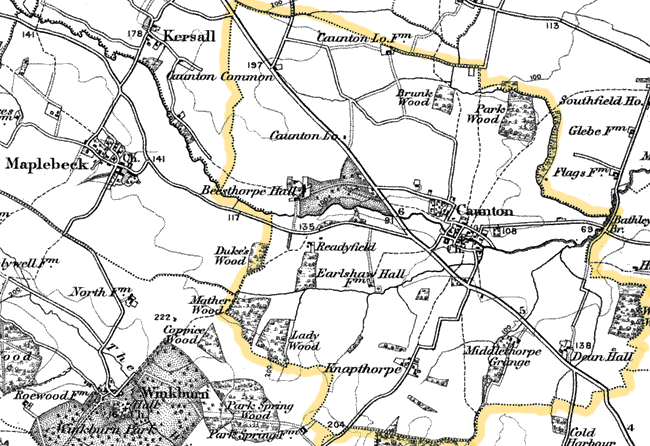Caunton
Caunton described as growing "Wheat, Roses And Deans"

St. Andrew's church, Caunton (photo: A Nicholson, 1984).
OF Caunton it used to be said that it lay a league away from everywhere except Heaven. It is sequestered still with its venerable church, its manor house, its inn, its windmill, its nearby smithy, and its red-roofed cottages amid surrounding greenery, the little osier-feeding Beck flowing beside its churchyard, all half a mile or 30 removed from the attractive main road from Newark to Ollerton and Worksop. Not long ago it narrowly escaped invasion by a railway, as in 1919 the Notts. Agricultural Committee forwarded a scheme for a line which would have run from Kelham through this village and on by Maplebeck and Wellow to Ollerton, but in the welter of post-war adjustments the plan fell through and Caunton retains its "splendid isolation."
Half a century ago the Rev. R. H Whitworth wrote that its soil was "cloggy and clarty, deep, rich and heavy . . . and has been known to grow good wheat, roses and deans." The stiff red clay persists but it is good ploughland and yields bountiful crops as of yore. The other two references are to Dean Hole, the famous rosarian, who might almost be termed the patron saint of the parish.
The village is supposed to take its name from an early Saxon of some such name as Calnorth, whose "tun" or farm it was, and the old form of the place-name preserved the "l" for centuries: in Domesday it appears as Calnestone. But there had been a settlement hereabouts long ere Saxon days, for cores of black flint, rough pottery and abundant remains of domestic animals go back to Neolithic times, many centures B.C., and Mr. Bernard Smith has expressed the view that indications of Roman occupation would probably reward investigations in this part of the valley of the Beck.
In hands of monks
When Domesday Book was compiled (1086) some 30 acres here were in the king's hands as pertaining to his manor of Mansfield; other owners under the feudal system included the great Roger de Busli (who in 1088 founded Blyth Priory and built Tickhill Castle), Geoffrey Alselin, another Norman baron; the Archbishop of York held another portion and the lord of Laxton had interests also. Its population would be about a hundred all told; there was a mill and a wood three miles long and half-a-mile wide which afforded pannage for pigs and firewood for the homes, which would be humble dwellings of timber and mud. Presently the Archbishop's fee passed to the prebend of N. Muskham, to which went the great tithes of the parish. Under Norman sway other ecclesiastical bodies acquired portions of the soil and as time passed the Knights Hospitallers, Rufford Abbey, the priories of Newstead and Shelford, and Peterborough Abbey, between them held no small proportion of its lands and rents; but the monks were usually good landlords, and the freemen and villeins of Caunton probably suffered little in comparison with others
'Peculiar' of Southwell
From 1171 until near the close of the 18th century the parish annually sent to Southwell its Pentecostal offering of 10d. —a sum below the average in the deanery of Newark to which it belonged. By grant of Edward II the Chapter of Southwell enjoyed the right of assize of bread and ale and survey of weights and measures, and his successor confirmed the prebendary of N. Muskham in his judicial "view of frank pledge" for the maintenance of law and order among his tenantry, and the right to waifs and Strays and to hold a court at Muskham twice a year, which his tenants had to attend. As a prebendal village Caunton formed part of the "Peculiar" of Southwell, and was exempt from the jurisdiction of the archbishop. The Chapter not only regulated its religious affairs, but exercised the authority, elsewhere vested in archdeacons to punish such offences as slander, perjury, and immorality by fines, suspensions, penance excommunications, and by corporal punishment. A curious instance of slander occurred in 1472, when Alice Row accused Thos. Lambley of defaming her character. He had jocularly said that she had stolen 40s.: the Case came before the Chapter, but its judgment is not recorded. In the same vear the vicar, Wm. Hull, was excommunicated by the Chapter for sorcery, and when he illegally took upon himself to excommunicate a woman of the parish he was compelled to make a public confession of his fault, in church, and was ordered to resign the living within a stipulated period.
A "Miracle"
The saintly but unfortunate Henry VI was said to have power to perform miracles, and one of his achievements is credited to this place. Whilst playing football at Caunton a youth named Bartrum injured his foot so seriously that, being racked with protracted pain, he vowed to undertake a pilgrimage to the king at Windsor, for relief and cure. The contemporary chronicler relates that the merciful Henry spared him this toilsome journey. He appeared to the sufferer in a dream, and when Bartrum awoke his foot was sound and well.
With the dissolution of the monasteries great changes took place, for the monastic lands were confiscated and sold. Shelford's manor and properties here went with that priory to Sir Michael Stanhope, two monastery-mongers purchased the Caunton possessions of Newstead; two others named Thornehill bought Deane Hall, formerly the property of the Hospitallers; the gild-house of St. John, known as Kirkelath, and the property of the Trinity Gild were sold to two others, and the houses belonging to the chantry passed to Wm. Poole and Edw. Downing. These were all purely business transactions, and the properties concerned were for the most part quickly sold off. Sir Henry Spelman, who died 300 years ago, claimed that such sacriligeous sales were attended with ill fortune to their purchasers, and he might have adduced the fate of Sir Michael as evidence, for he was involved in the downfall of his brother-in-law, the Protector Somerset, and, like him, was beheaded on Tower Hill. This dispersal of old religious possessions marked the end of the old order of things and the beginning of a new era at Caunton, as elsewhere.
The influx of new owners was not the only local result of the Reformation. Catholic families remained to suffer persecution as recusants. Arthur Rookesby, the new owner of Deane Hall, was among them, and the Yarboroughs were prosecuted several times for adhesion to "the Old Religion."
 Caunton parish in the 1880s.
Caunton parish in the 1880s.The principal manor
In 1437-8 a moiety of the principal manor had been settled upon Sir Robert Markham and his heirs; in 1567 it was possessed by William Whitmote who, being sued for the whole manor by claimants named Birkett and Anderson, called Robert Markham to warrant his right. From him it passed to the Broomes but Thomas Broome had to defend his title to it when sued by Rd. Hacker of Flintham, who subsequently purchased it. The Hackers did not keep it long for in the reign of Charles II it was sold to Sir Francis Willoughby, of Wollaton, and his descendants maintained their interests here until 1867, when Lord Middleton sold his rights for £26,000. In 1594 Francis Harwar obtained Deane Hall from Rd. Mansfield, to whom he passed his manor at West Leake in exchange. Middle-aged inhabitants then living had witnessed the most remarkable revolution in Caunton's history. Their children were to witness further excitements, for the Civil War did lot leave the village untouched.
In November, 1645, the Scots army (to which King Charles surrendered a few months later) stretched its encampment from within a mile of the village, through Kelham to the bank of Trent at a point where the Great North Road crosses the river, and its soldiers must have been familiar and not altogether welcome callers here. Like other parts of the county Caunton had been levied upon for money and supplies by Cavaliers and Roundheads alike, and had to pay a heavy series of contributions for the maintenance of the Parliamentary army. Henry Taylor, a farmer proprietor, was one of these who suffered for loyalty to the king, and in 1651 he had to compound for his estate: it was alleged that he bribed the Notts. Commissioners so that his fine was less than it should have been, and the offenders were brought to book.
A return of 1678 showed that there were then 193 inhabitants of age to take the Sacrament; the Papists had apparently died out for there was reported to be none in the parish, but there were 17 persons who wilfully abstained from communicating at the appointed times. Some of these may have been Quakers for in that year Thomas Oakland and his wife were fined and distrained upon, £10 worth of their stock being sold for £5, for absenting themselves from church and refusing to pay the parson his tithes.
The Warens
The Warens of old had here a capital messuage called "le Halle," with lands and tenements held partly from Newstead Abbey and the prebend of North Muskham, with other properties that formed part of the Barry Manor. The capital messuage was sold to the Bristowes, who, in 1714, parted with it to Ald. Herring, of Newark; the Bristowes converted the old chantry chapel into a family burial place, but the old stained glass that formerly adorned its Windows has long since gone. Contiguous to the manor-house was an ancient chapel which had become ruinous, and shortly before they sold the property the Bristowes demolished its remains to enlarge the bowling green, when bones and coins of the 13th and 14th centuries were unearthed. The enclosure of the open fields took place in 1793-5 when the prebendary of North Muskham was awarded 171 acres and the vicar 124 acres in lieu of tithes. Fields then supplanted the old narrow strips of land and the village began to assume its modern appearance. In 1792 the population numbered 310; at the beginning of the 19th it was 366; the census of 1851 marked its zenith with 611, but then, as in other villages, it declined; the pull of the towns was felt, and in 1901 the number of inhabitants had fallen to 345—21 fewer than a century earlier.
